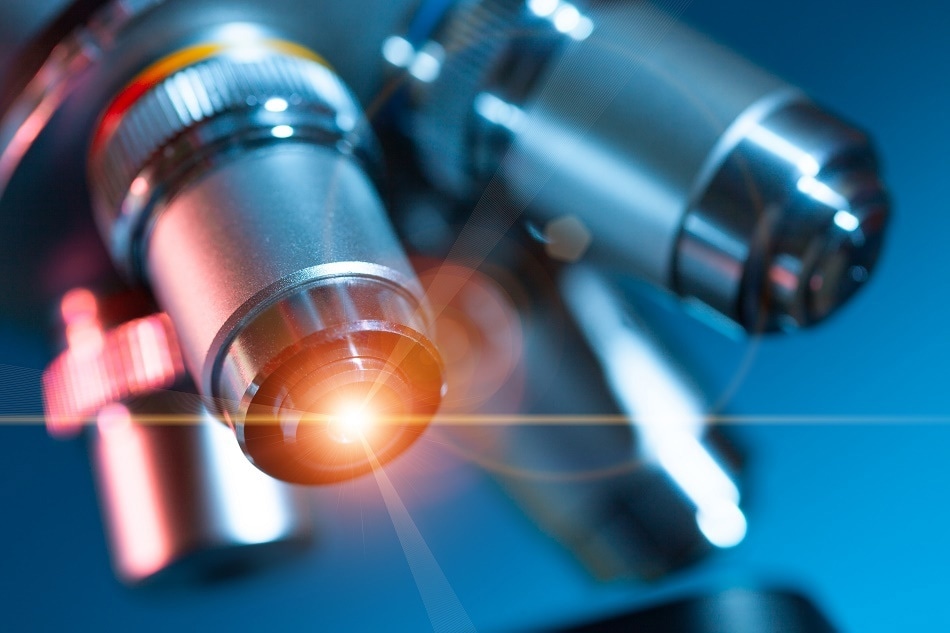
Image Credits: science photo/shutterstock.com
Bessel beam microscopy, and the techniques that preceded it, are generally used to image live cells in 3D. Bessel beams have a greater capability than other super-resolution imaging techniques for many reasons, and in this article, we look how these Bessel beam microscope systems work.
Bessel beam microscopy came to the fore after traditional light-sheet microscopy and plane-illumination microscopy were not capable of providing the spatiotemporal resolution of a living cell desired by researchers. Whilst many of these techniques can image live cells, there are often restrictions and Bessel beam microscopy can provide higher resolutions than many of these techniques. To date, there are some small restrictions with the samples that can be used in a Bessel beam microscope, and these are usually limited to fixed living cells.
Some of the key advantages of Bessel beam microscopy over other super-resolution techniques include the ability to produce a near isotropic spatial resolution, with low photobleaching and low photodamage.
New imaging techniques arise because of a challenge with current imaging methods. One of the main challenges with other imaging techniques, particularly light-sheet microscopy, is that only the side of an object (which can be a “thick” object) that is in line with the objective lens is illuminated. Thick objects cause the beams to scatter and propagate along the z-axis of a material, which results in a lower image quality. Bessel beam microscopes have overcome this challenge by scanning laterally in the plane of focus. The photons in a Bessel beam can self-heal, which creates a constructive interference and a 50% increase of ballistic photons in the propagation direction. Overall, it leads to an increase in the image quality.
The Bessel Beam
A Bessel beam can be formed from different types of radiation, including electromagnetic, acoustic and gravitational radiation, and is a propagating beam that does not diffract or spread out. The amplitude of a Bessel beam is governed by Bessel functions of the first kind. This function is a mathematical expression in the form of series expansion around X=0.
Bessel beams are self-healing beams, so even if they become obstructed by an object (such as an imaging sample), the beam will re-construct itself further down the beam pathway. However, the one snag is that a true Bessel beam can not be constructed, as it would require an infinite amount of energy. Instead, researchers use an approximation to change another beam into a beam that almost mimics the true effects of a Bessel beam. The most common way of generating these approximated Bessel beams is by firing a Gaussian beam at axisymmetric diffraction gratings, or through an axicon lens – which is a unique optical element with a conical surface.
Applying the Bessel Beam to Microscopy
Bessel beam microscopy is a plane illumination microscopy technique that takes images in a wide field mode and uses various modes of structured illumination, including two photon illuminations. There are three modes which are commonly used. These are plane illumination, structure plane illumination and TP plane illumination.
The imaging method centers around the use of an axicon to create a Bessel-like beam. It is the addition of the axicon in these microscope systems that creates a Bessel beam by changing its point spread function (PSF). In addition to the axicon component, Bessel beam microscope systems also contain a lens placed at a focal length away from the image plane and a camera which is placed at a defined distance from the axicon.
Whilst the spatial resolution is generally high and the photodamage low, there are variations between the different modes regarding these parameters. Overall, the spatial depths are generally the same, other than the plane illumination mode has a much greater imaging depth in the z-direction. However, in-plane illuminations offer the lowest degree of optical section capability.
TP plane illumination modes offer the best optical sectioning capabilities, as well as the joint highest speed and joint lowest photodamage alongside plane illumination modes. However, this mode can only image in black and white, whereas the other modes can image in colour. Structured Illumination modes sit in the middle ground for many of the parameters but cause a higher degree of photobleaching than the other modes.
Overall, Bessel beam microscopes can take images of living cells at 200 frames per second (fps) and can image up to 40 planes per second. The light sheets formed in Bessel beam microscopes are much thinner (and quicker) than other plane-imaging techniques, and this enables the microscope to image hundreds of 3D image stacks without causing photobleaching to the image or introducing high levels of phototoxicity to the cell being imaged.
Sources:
Mapping Ignorance: https://mappingignorance.org/2013/12/23/bessel-beam-plane-illumination-microscopy-another-smart-solution-for-an-old-challenge/
“3D live fluorescence imaging of cellular dynamics using Bessel beam plane illumination microscopy”- Gao L., et al, Nature Protocols, 2014, DOI: 10.1038/nprot.2014.087
“Imaging performance of Bessel beam microscopy”- Snoeyink C., Optics Letters, 2013, DOI: 10.1364/OL.38.002550
“Rapid three-dimensional isotropic imaging of living cells using Bessel beam plane illumination”- Planchon T. A., et al, Nature Methods, 2011, DOI: 10.1038/nmeth.1586
Disclaimer: The views expressed here are those of the author expressed in their private capacity and do not necessarily represent the views of AZoM.com Limited T/A AZoNetwork the owner and operator of this website. This disclaimer forms part of the Terms and conditions of use of this website.